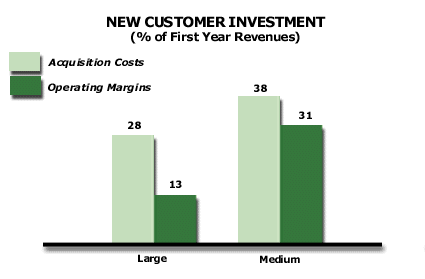Analysis 65: The Investment In and First Year Margin on a New Customer Relationship
EXHIBITS:

| HOW TO INTERPRET THE ANALYSIS: This exhibit is something like a payback analysis. It displays the acquisition costs and operating margins that the company might expect for gaining either a Large or a Medium customer in a Get In event. In this industry, the company would have to spend, on average, 28% of the first year's revenue in order to Get In a Large customer relationship. It would take more, 38% of the first year's revenue to acquire a Medium customer. Once acquired, a Large customer would generate a 13% profit margin as a percentage of first year's revenues. At the end of the first year, the company would have deficit of 15% of the first year's revenues to cover in following years before it paid back its investment in Getting In the Large customer. The Medium customer situation is more promising. While it does cost more to acquire a Medium customer than it does a Large customer, the average Medium customer's expected operating margin is also a great deal higher. At the end of the first year, the company has a deficit of only 7% of the first year's revenues to be covered in subsequent years before its investment in acquiring the customer begins to produce a return.
PURPOSE: This analysis helps the company evaluate the investment it makes in a new or expanded customer relationship. The company would use this analysis as part of its effort to upgrade its customer mix. APPROACH: The marketing and sales function, along with finance, breaks the total marketing and sales spending in the year into two categories: the servicing of existing customers and the recruitment of new customers. The spending devoted to new customer volume is then divided by the new customer volume that the company realizes during the period to produce the investment figure. The analysis should be done for each position on the customer size/role segmentation matrix. In the majority of cases, the company makes a hidden investment in a new customer relationship. This investment is hidden because the company writes it off as an expense during the year in which it is incurred. It is an investment, nonetheless. This analysis estimates the investment, as a percentage of first year's revenue, for each new customer relationship of a given size. The same analysis should extend into other sizes and role segments. The investment is the difference between the acquisition costs and the first year operating margins. In the example above, the Large customer segment requires an investment of 15% of the first year's revenue. The Medium segment requires an investment of 7% of first year's revenues. These investments then compare directly to the operating margins that these relationships provide in their first year of activity, or perhaps, even in the long term. The company can then determine how long it takes to pay back its hidden investment in these new customer relationships and re-orient its customer calling patterns away from those relationships that have very long pay back. Alternatively, it can change its approach to recruitment of these high-cost, long-pay-back customers in order to reduce the investment costs these customers entail and make them more attractive. |
|
Recommended Reading |
| For a greater overall perspective on this subject, we recommend the following related items:
Analyses:
Symptoms and Implications: Symptoms developing in the market that would suggest the need for this analysis.
Perspectives: Conclusions we have reached as a result of our long-term study and observations.
|
